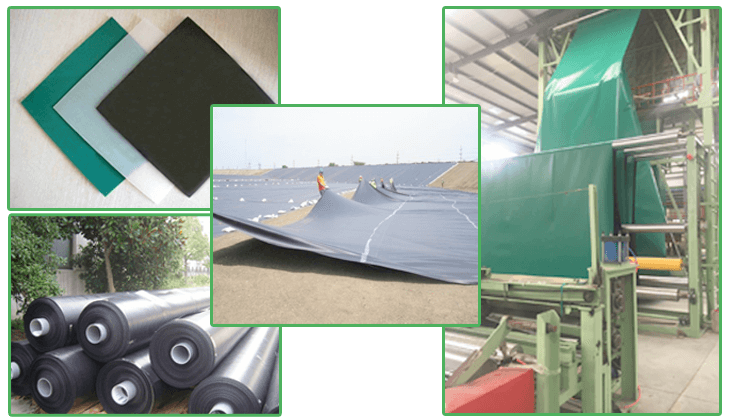Construction Scheme of Composite Geomembrane in Channel Anti-seepage River Treatment – Ⅱ
Laying method
According to the range of the film, it can be divided into full-lay, half-lay, and bottom-lay. The semi-paved and bottom-paved styles are mainly suitable for wide and shallow channels or canals with trees on the slope.
1. Full paving; canal slope and canal floor. The laying method can be selected according to the anti-sliding stability of the canal slope, and the specific methods are trapezoid, step, zigzag, pentagon, etc.
2. Half paved; the bottom of the canal is fully paved, and the height of the membrane on the canal slope is 1/2 to 1/3 of the normal water level of the canal.
3. Bottom bunk. Paved only the bottom.
Channel Engineering Construction
Construction operation procedures: clean up the base trench → geomembrane laying → joint construction, inspection → connection and anchoring with surroundings → acceptance → protective layer construction.

1. Clean the base groove
Peel according to the design, and remove all mud, garbage, trees, grassroots, stones and other sharp edges and debris that may damage the geomembrane. Level up the compacted land, repair pits and cracks, and dig anchor trenches. When there are a yin and yang angle on the base, it should be rounded with a radius of not less than 0.5m. Drainage should be carried out in areas with standing water and high groundwater levels.
2. Geomembrane laying
According to the different types of geomembrane and design requirements, choose the appropriate joint splicing method.
1. When welding joints are selected, the construction process is: laying, cutting, aligning, aligning, pressing film setting, wiping the dust, welding inspection, welding, inspection and repair, re-inspection, and acceptance.
2. When selecting a composite geomembrane, the construction process is as follows: laying film and welding film → stitching the bottom cloth → stitching the surface cloth (2 cloths and 1 film.) The stitching requires moderate tightness and natural smoothness to ensure that the membrane and the cloth are jointly stressed.
3. When laying the geomembrane in the channel, the laying direction can be determined based on the actual conditions of the project, based on the principle of minimum joints, easy construction, and reasonable cutting. The joints should be located on the plane, avoiding corners.
4. When the foundation trench is soil, it should be sprinkled with water to make the geomembrane tightly combined with the channel bed foundation trench. When the foundation trench is a concrete structure, a filament hot-rolled composite geomembrane and the foundation trench should be used. Weight. 2.0% SBC120 adhesive cement cement bonding.
5. When laying the geomembrane, it should be spread in order from the downstream to the upstream in parallel or perpendicular to the slope line. Don’t pull too tightly, leave 1.5% slack in both the vertical and horizontal directions.
6. The laying height of the geomembrane on the slope of the channel shall be above the highest water level and have a certain superelevation. The superelevation value shall be determined according to the water level or wave climbing height. It shall not be less than 0.5m and shall be fixed.
7. When welding the geomembrane, the surface of the substrate should be dry and the moisture content should be below 15%. The membrane surface should be wiped clean with dry gauze.
3. Connection and anchoring
1. The geomembrane is connected to the soil foundation. The geomembrane is directly buried in the anchor trench, filled with soil and compacted, and must not seep or be pulled out at the anchor.
2. The connection between geomembrane and building concrete can be riveted with angle steel or metal slats, or bolted to the concrete layer.
4. Protective layer construction
1. When the protective layer is a concrete structure, expansion joints should be reserved as designed.
2. When using the compaction method to fill the soil protective layer, the use of horn mills is prohibited.
3. When filling the sandy loam, light loam, and middle loam protective layers by the soaking method, set aside 10 to 15% of the subsidence for the fill section size. After the repeated water immersion subsidence is stabilized, the water is slowly drained, cracks are filled, and the shots are taken and renovated to the design required section.
4. Canal bottom, canal slope or different canal sections can adopt combined protective layers with different impact resistance and different materials.
Precautions
1. The excavation section and elevation of the channel shall meet the design requirements. The trench bed excavation section avoids excessive excavation. The fill section should be compacted with a water layer, and the collapsible canal section should be pre-soaked or strongly compacted with water to avoid large deformation.
2. For projects with anti-freeze requirements, anti-seepage structures should adopt anti-freeze measures. Rigid foam insulation can be laid under the anti-seepage layer, or non-frost heaving soil can be replaced. In general, the insulation layer can be laid in full section.
